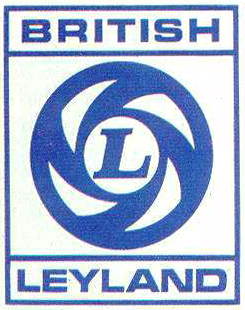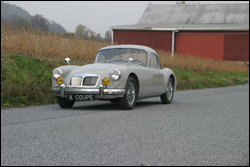
|
British Leyland Motors
The roots for British Leyland began to take form in 1952 when Austin and the Nuffield Group merged to form British Motor Corporation (BMC). The new company included Austin, the newly-birthed Austin-Healey, Morris, M.G., Riley, and Wolseley, as well as many suppliers of bodies, carburetors and other key components. In 1966, BMC and Jaguar-Daimler joined forces to create British Motor Holdings, and finally in late 1967—at the urging of the British government, BMH merged with Leyland (including Rover-Triumph) to create the British Leyland Motor Corporation.
Although the company was beset with poor management, low-productivity, extensive labor unrest and poor quality, it still continued to produce some very memorable sports cars, which were primarily intended for the American market. The cars of the BL era included Austin-Healey Sprite, Jaguar E-Type 4.2 and V-12, XJ-6, XJ-12, M.G. Midget, MGB, MGB/GT, MGC and MGC/GT, Triumph Spitfire, GT6 TR-250, TR-6, TR-7 and TR-8.
In addition to these popular British Cars, in the era long before British Leyland became a dirty word, the antecedent companies were responsible for some truly wonderful sports cars and sporting sedans. Those models included the M.G. TC, M.G. TD, M.G. TF, Austin-Healey 100/4, 100/6 and 3000, Jaguar XK-120, XK-140, XK-150, and the Triumph TR-2, TR-3, TR-4 and TR-4A.
More than 50 years after many of these cars first rolled out of the factories in Coventry, Abington, Warwick or Speke, many are still on American roads and cherished in American garages.
Titles by the Author
- Austin Healey Sprite Mark1 Workshop Manual
- Austin-Healey 100/4 Owner's Handbook: 1953-1956
- Austin-Healey 100/6 Owner's Handbook: 1956-1959
- Austin-Healey 3000 Mk I and Mk II Driver's Handbook: 1959-1963
- Austin-Healey 3000 Mk III Driver's Handbook: 1964-1968
- Austin-Healey Sprite Mk I Driver's Handbook: 1958-1961
- MG Midget TD Driver's Handbook: 1950-1953
- MGA 1500 Driver's Handbook: 1960
- MGA 1500 Parts Catalogue: 1955-1959
- MGA 1600 Driver's Handbook
- MGB Tourer and MGB GT Special Tuning Manual: 1975-1980
- Mini Workshop Manual: 1959-1976
- Morris Minor Workshop Manual: 1956-1971
- The Complete Official 1275cc
Austin-Healey Sprite / MG Midget:
1967, 1968, 1969, 1970,
1971, 1972, 1973, 1974 - The Complete Official MGB:
1962, 1963, 1964, 1965,
1966, 1967, 1968, 1969,
1970, 1971, 1972, 1973, 1974 - The Complete Official MGB:
1975, 1976, 1977, 1978, 1979, 1980 - The Complete Official Triumph GT6, GT6+ & GT6 MK III:
1967, 1968, 1969, 1970,
1971, 1972, 1973 - The Complete Official Triumph Spitfire 1500:
1975, 1976, 1977,
1978, 1979, 1980 - The Complete Official Triumph Spitfire MK III, MK IV and 1500:
1968, 1969, 1970, 1971,
1972, 1974, 1974 - The Complete Official Triumph TR7: 1975, 1976, 1977, 1978,
1979, 1980, 1981 - The Complete Official Triumph
TR4 & TR4A:
1961, 1962, 1963, 1964,
1965, 1966, 1967, 1968 - The Complete Official
948 cc & 1098 cc
Austin-Healey Sprite / MG Midget:
1961, 1962, 1963, 1964, 1965, 1966 - The Complete Official
Austin-Healey 100-Six and 3000:
1956, 1957, 1958, 1959,
1960, 1961, 1962, 1963,
1964, 1965, 1966, 1967, 1968 - The Complete Official
MG Midget 1500:
1975, 1976, 1977, 1978, 1979 - The Complete Official
Triumph TR6 & TR250:
1967, 1968, 1969, 1970, 1971,
1972, 1973, 1974, 1975, 1976 - The Complete Official
Triumph TR2 & TR3:
1953, 1954, 1955, 1956, 1957,
1958, 1959, 1960, 1961 - Triumph Stag Repair Operation Manual: 1971-1973
- Triumph TR2 & TR3 Parts Catalogue: 1953-1963
- Triumph TR250 Spare Parts Catalogue: 1968
- Triumph TR4 Parts Catalogue: 1961-1964
- Triumph TR4A Spare Parts Catalogue: 1965-1967
- Triumph TR7 Parts Catalogue: 1975-1978
- Triumph TR7 Parts Catalogue: 1979-1981
![[B] Bentley Publishers](http://assets1.bentleypublishers.com/images/bentley-logos/bp-banner-234x60-bookblue.jpg)
